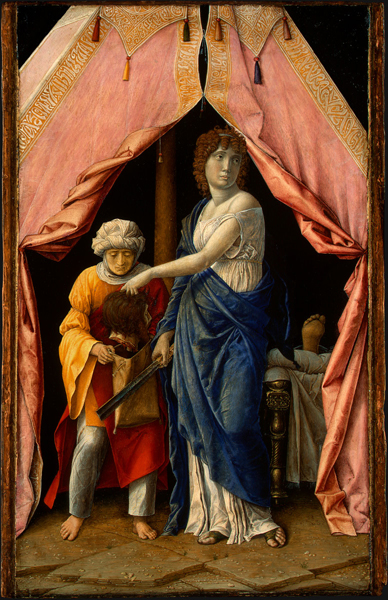Judith with the Head of Holofernes

Andrea Mantegna or follower, possibly Giulio Campagnola
Judith with the Head of Holofernes, c. 1495–1500
Tempera on panel, 30.1 x 18.1 cm (11 7/8 x 7 1/8 in.)
National Gallery of Art, Washington, DC, Widener Collection
Image courtesy of the Board of Trustees, National Gallery of Art
1) Q: One of the figures in this painting is based on a classical statue of a Roman goddess. Which one, and why do you think so?
A: Draw out notions of idealism (that is, an artificially perfected standard of beauty) in relation to classical statuary. Relevant characteristics might include:
- Judith’s standardized facial features (compare to the more individualized, less attractive features of the maidservant)
- The pleasing contours and proportions of her body (compare to the maidservant’s stunted body)
- The gracefulness of her pose (compare to the maidservant’s hunched posture)
- The use of clinging drapery to simultaneously reveal and conceal the body and accentuate its movements (compare to the maidservant’s stiff, baggy clothing)
- The use of drapery folds to create elegant patterns of parallel and intersecting lines and curves (compare to the lack of folds in the maidservant’s drapery)
- Introduce the term statuesque: like or suggesting a statue in its majestic dignity, grace, and/or beauty
2) Q: Imagine the figure of Judith presented frontally and symmetrically, so that the left and the right side are identical. In what ways does the figure shown in the painting deviate from a rigidly frontal, symmetrical presentation?
A:
- Head swivels to her left while shoulders rotate toward her right
- Raised left arm reaches across her body while lowered right arm falls at side
- Pelvis is angled as hips thrust to right side
- Weight shifts onto straight right leg while bent left leg swings free
- Note that the figure is designed in such a way that each shift in position or movement is answered by a countering shift. Note that this type of complex, asymmetrically balanced pose is found in many classical statues and is denoted by the Italian word contrapposto (counterposed).
3) Q: Why do you think Renaissance artists adopted the antique device of contrapposto in their paintings and sculptures? What does contrapposto add to the figure of Judith compared with the frontal and symmetrical figure you imagined earlier?
A: Responses might include:
- Contrapposto conveys a sense of lifelike movement; a frontal and symmetrical figure would appear rigid, frozen, or static.
- Contrapposto suggests three-dimensional rotation through space; a frontal and symmetrical figure would appear flatter.
- Contrapposto allows figure to “multitask,” suggesting more than one moment in time. (Judith glances over her shoulder toward the scene of her past act of violence while dealing with the consequences of that act.)
4) Q: Contrapposto is an example of the classical device of antithesis, meaning opposite or contrast, which was favored in antiquity as a means of enlivening visual and rhetorical compositions. What other examples of antithesis do you see in Judith and Holofernes?
A: Responses might include:
- Brightly illuminated foreground vs. pitch-black background; described by the Italian term chiaroscuro (“chiaro” meaning light or clear, “scuro” meaning dark)
- Short, crouching, older maidservant vs. taller, erect, more youthful mistress
- Gruesome, shaggy head of Holofernes (seen from behind) vs. placid, elegantly coiffed head of Judith (seen from front)